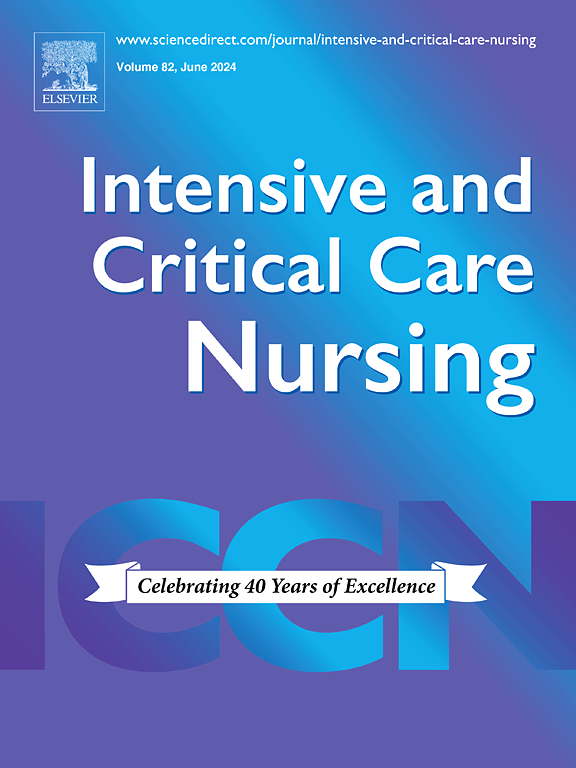The effectiveness of FOUR score versus GCS scale in predicting mortality and morbidity in traumatic brain injured patients in intensive care: A systematic review
IF 4.9
2区 医学
Q1 NURSING
引用次数: 0
Abstract
Background
Traumatic brain-injury (TBI) is one of the leading causes of death and disability worldwide. In intensive care, the Glasgow coma scale (GCS) is widely used to assess severity of brain injury. An alternative tool is the Full Outline of UnResponsiveness (FOUR) score which assesses stages of locked-in syndrome and brain herniation. The purpose of this study is to evaluate the effectiveness of both assessment tools in predicting mortality and morbidity in critically ill patients with TBI.
Methodology
Systematic review guided by the Joanna Briggs Institute (JBI) Manual for Evidence Synthesis (2021). A comprehensive database search was conducted for the period January 2005–September 2023. Searches repeated in February 2025. Primary research comparing FOUR with GCS, published in English, including adults aged 16 and over and patients with TBIs in intensive care were included. Studies were appraised using JBI critical appraisal tools. Data was narratively synthesised.
Results
Eleven studies were included. No study reported significant statistical differences between GCS and FOUR score in predicting mortality. Area under the curve and receiving operating characteristic curve values for both tools were rated good to excellent (Range 0.80–0.96) in predicting mortality. Morbidity was only reported in 6/11 studies. Neither tool appeared to effectively predict morbidity however, there was great variability in which and how morbidity outcomes were assessed.
Conclusions
Both assessment tools perform similarly in predicting mortality and morbidity in TBI in intensive care.
Implications for clinical practice
Further research to determine the additional clinical benefits of FOUR assessment in this population is recommended. The development of core morbidity outcome measures in patients with TBI is required to evaluate if these tools effectively predict morbidity. Effective prognostication may assist healthcare providers in managing resources as well as providing patients and families with realistic expectations of long-term recovery.
4评分与GCS量表在预测颅脑损伤重症监护患者死亡率和发病率方面的有效性:一项系统评价
背景创伤性脑损伤(TBI)是世界范围内导致死亡和残疾的主要原因之一。在重症监护中,格拉斯哥昏迷评分(GCS)被广泛用于评估脑损伤的严重程度。另一种可选择的工具是无反应性评分(FOUR),它可以评估闭锁综合征和脑疝的各个阶段。本研究的目的是评估两种评估工具在预测TBI危重患者死亡率和发病率方面的有效性。方法:乔安娜布里格斯研究所(JBI)证据合成手册(2021年)指导的系统评价。对2005年1月至2023年9月期间进行了全面的数据库检索。搜索在2025年2月再次进行。比较FOUR和GCS的初步研究,包括16岁及以上的成年人和重症监护的tbi患者。使用JBI关键评估工具对研究进行评估。数据以叙述的方式合成。结果共纳入6项研究。没有研究报告GCS和FOUR评分在预测死亡率方面有显著的统计学差异。两种工具的曲线下面积和接收工作特征曲线值在预测死亡率方面被评为良好至优秀(范围0.80-0.96)。只有6/11的研究报告了发病率。这两种工具似乎都不能有效地预测发病率,然而,在评估发病率结果的方式和方式上存在很大的差异。结论两种评估工具在预测重症监护室TBI的死亡率和发病率方面表现相似。建议进一步研究以确定在这一人群中进行FOUR评估的额外临床益处。需要开发TBI患者的核心发病率结局指标来评估这些工具是否能有效预测发病率。有效的预测可以帮助医疗保健提供者管理资源,并为患者和家属提供长期康复的现实期望。
本文章由计算机程序翻译,如有差异,请以英文原文为准。
求助全文
约1分钟内获得全文
求助全文
来源期刊

Intensive and Critical Care Nursing
NURSING-
CiteScore
6.30
自引率
15.10%
发文量
144
审稿时长
57 days
期刊介绍:
The aims of Intensive and Critical Care Nursing are to promote excellence of care of critically ill patients by specialist nurses and their professional colleagues; to provide an international and interdisciplinary forum for the publication, dissemination and exchange of research findings, experience and ideas; to develop and enhance the knowledge, skills, attitudes and creative thinking essential to good critical care nursing practice. The journal publishes reviews, updates and feature articles in addition to original papers and significant preliminary communications. Articles may deal with any part of practice including relevant clinical, research, educational, psychological and technological aspects.
 求助内容:
求助内容: 应助结果提醒方式:
应助结果提醒方式:


